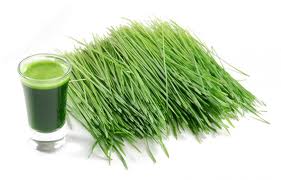 Wheatgrass juice is the extracted liquid from the common wheat plant, Triticum aestivum. While often sold as a juice, powdered concentrate can also be commonly found on supermarket shelves and health food stores. As a nutritionally beneficial plant, wheatgrass juice provides a great source of chlorophyll, amino acids, minerals and vitamins. Wheatgrass is highly consumed due to its ease of growth, with many consumers choosing to grow this food in their homes.
Wheatgrass juice is the extracted liquid from the common wheat plant, Triticum aestivum. While often sold as a juice, powdered concentrate can also be commonly found on supermarket shelves and health food stores. As a nutritionally beneficial plant, wheatgrass juice provides a great source of chlorophyll, amino acids, minerals and vitamins. Wheatgrass is highly consumed due to its ease of growth, with many consumers choosing to grow this food in their homes.
While wheatgrass juice is a popular modern beverage, its use was first popularized in the 1930s when Schnabel, a agricultural chemist, began experiments with young grasses in his lab. Among his findings, wheatgrass stood out for its high nutrition content and ease of growth. Knowing these benefits, Schnabel highly touted the benefits of wheatgrass juice, leading to partnerships with Quaker Oats and the American Dairy Corporation, who sold his idea in its concentrated form. Simple to grow and juice, adding wheatgrass to your diet will surely increase your health and digestion.
Key Nutrients
Wheatgrass juice provides beta carotene, vitamin A and vitamin C. Wheatgrass juice also includes iron, calcium and potassium.
Health Benefits
Vitamin A – Vitamin A, when converted into retinaldehyde, is a vital compound for healthy eyes. Furthermore, vitamin A is believed to fight against cataracts, macular degeneration and glaucoma. Vitamin A strengthens the membranes of the human body such as mucous membranes, respiratory, urinary and intestinal tracts. It is also essential for the lymphocytes, or white blood cells, that fight infection once in the body.
Vitamin C – Regular consumption of foods rich in vitamin C helps the body develop resistance against infections and scavenges harmful, pro-inflammatory free radicals. Vitamin C also helps to prevent respiratory problems such as asthma and lung cancer. Vitamin C has been shown to lower blood pressure, and therefore lessen the probability of hypertension.
Potassium – Potassium is an essential mineral which aids in fluid regulation, protein synthesis and cardiovascular health. High levels of potassium are associated with reduced risk for stroke, improved blood pressure control as well as bone health.
Iron –Iron, found in red blood cells, is an integral part of hemoglobin. Hemoglobin carries oxygen from the lungs to the cells. Iron is an essential component of many enzymes necessary for various chemical reactions in the body.
Calcium – Calcium is an important mineral for bone and teeth growth and maintenance. It is also an important mineral in terms of cardiovascular function.
Season
Wheatgrass juice can be found year round.
Nutrition Information
Per 100 grams:
Calories (cKal): 99
Protein (grams): 1.82
Total Fat (grams): .49
Carbohydrates (grams): 25.31
Fiber (grams): 15
Buying and Storing
Wheatgrass juice can be purchased in its powdered concentrate form, which can be stored for months at a time. Instead of buying wheatgrass juice, make sure to buy fresh wheatgrass and juice yourself.
Best Way to Add to Diet
Wheatgrass juice is best served as a beverage. With this said, try adding some wheatgrass to a salad dressing for an extra amount of taste and nutrition.
Wheat Grass Juice Recipe
Pan Seared Scallops with Wheatgrass-Basil Sauce

 Not Sure What Healthy Foods To Eat?
Not Sure What Healthy Foods To Eat? This week we take a look at one of my favorite healthy foods...the mighty Avocado.
This week we take a look at one of my favorite healthy foods...the mighty Avocado.
No comments yet.